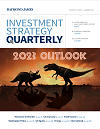10-Year Expected to Creep Higher to 1.5% by Year-End
January 12, 2021
Doug Drabik and Nick Goetze, Raymond James fixed income managing directors, expect a slight steepening of the yield curve over the course of 2021.
To read the full article, see the Investment Strategy Quarterly publication linked below.
More than 39 years of general interest rate decline, 23 years of moderate inflation, five recessions and the longest-ever expansionary period preceded 2020’s pandemic-triggered recession, unprecedented central bank intervention and historically low interest rates. Fixed income total returns have benefitted for years (if not decades) from general interest rate decline. There is an inverse relationship between rates and price. As rates decline, prices increase. The year 2020 was no exception, and Treasury, corporate and municipal bonds all boasted solid total returns.
Market conditions
Just as all corners of the world have been impacted by the global pandemic, so have all corners of the fixed income market, as spreads, volatility, and rate levels have been affected. The pandemic-induced recession officially began in February and prompted significant central bank (Federal Reserve [Fed]) and government response through fiscal and monetary actions. The Fed’s balance sheet, which had begun the year at ~$4.1 trillion in asset size, has ballooned to over $7.2 trillion via implemented emergency lending facilities, bond purchase programs and other stimulus-related bills. Treasury yields have declined 30% on the long end and over 90% on the short end of the Treasury curve, creating an even flatter sloped curve during 2020.
Looking forward
The variables are numerous and atypical, thereby challenging forecasts on how the markets emerge in 2021.
The base case scenario presumes that the vaccine is effective and quickly disseminated. This will initiate a rise in consumer confidence and allow businesses to gravitate toward their normal and intended business plans. Assuming much of the recovery begins taking shape in the second half of the year, the intermediate and longer end of the curve will push higher in yield. The 10-year Treasury, which will likely end 2020 around 1.00%, will creep higher in yield in 2021 to about 1.50%. The shorter end of the curve is directly influenced by the Fed. The implied Fed funds target rate is projected to keep its lower band at 0.00% through 2023, thus influencing 2021 where the 2-year Treasury rate projection will remain relatively low at around 0.25%. These combined moves point to a slight steepening of the yield curve over the course of 2021.
We believe a more bullish scenario also exists for bonds (prices higher, yields lower). The world’s central banks, including the Fed, have clearly taken the helm in controlling rates and driving economies. Four primary central banks (Federal Reserve, European Central Bank, Bank of Japan, People’s Bank of China) have ballooned their balance sheets from a combined total assets of around $6 trillion before the Great Recession (2008-2009) to over $27 trillion today. This year alone, they have increased their combined asset size over 36%. The flood of money has helped to keep rates down. Increasing domestic debt, which comes with higher interest expense, is an incentive for the Fed and the government to keep interest rates down. In addition, world interest rates continue to exhibit great disparity versus U.S. rates, which are significantly higher than many European and Asian rate environments. There is over $17.1 trillion of negative yielding debt worldwide. This helps to drive demand for higher-quality, higher-yielding U.S. securities, thus contributing as a headwind to higher rates. The thought that the U.S. would ever enter the world of negative interest rates has shifted from ‘never’ to ‘conceivable’ as global rates continue to drift apart.
The Fed and government are likely to continue with additional stimulus packages and persistence in keeping Fed funds at zero. In addition, there is a possibility that the COVID-19 vaccine takes much longer to distribute and the hangover effects that have crushed certain businesses take much longer to recover. Under these circumstances, we see a bullish scenario that could keep the 2-year closer to 0.00%, the 10-year Treasury lower to around 0.50% and higher stock and bond prices.
Read the full Investment Strategy Quarterly
The value of fixed income securities fluctuates and investors may receive more or less than their original investments if sold prior to maturity. They are subject to price change and availability. Risks include, but are not limited to, changes in interest rates, liquidity, credit quality, volatility, and duration. Past performance may not be indicative of future results. Investing in international securities involves additional risks such as currency fluctuations, differing financial accounting standards, and possible political and economic instability. These risks are greater in emerging markets. Companies engaged in businesses related to a specific sector are subject to fierce competition and their products and services may be subject to rapid obsolescence. Asset allocation does not guarantee a profit nor protect against loss.


